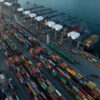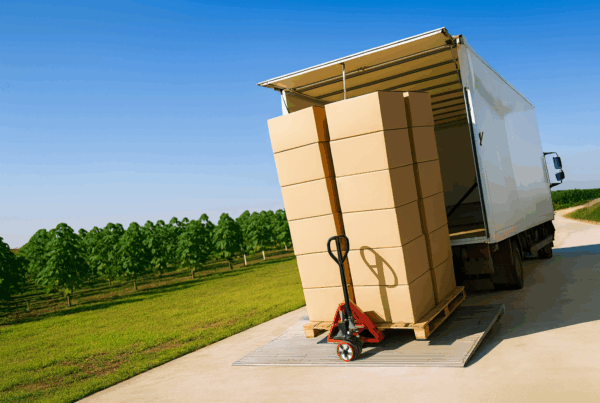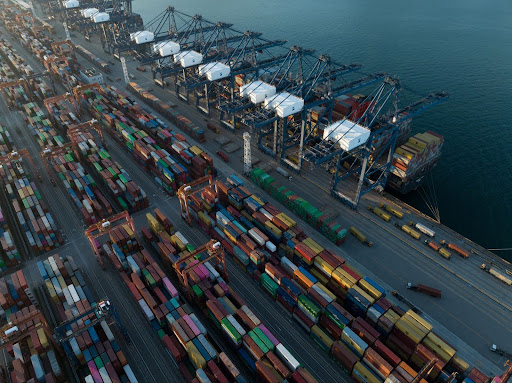In today’s fast-paced, global logistics environment, businesses are constantly searching for smarter, more efficient ways to move goods across vast distances. With rising pressure to cut costs, lower emissions, and meet tight delivery schedules, transportation strategies are evolving quickly. One approach gaining significant traction is intermodal transportation.
According to Statistics Canada, Canadian railways moved 34.0 million tonnes of intermodal freight in 2023, reflecting the importance of containerized, multi-modal logistics in supporting national and international trade. In this guide, we’ll explore how intermodal transportation works, the key components that make it successful, real-world applications across industries, and actionable strategies to help you implement it effectively within your supply chain.
What is Intermodal Transportation?
Intermodal transportation is a method of moving goods using two or more distinct transport modes such as rail, road, sea, or air, without handling the cargo itself during the transitions. The cargo remains in a single standardized container throughout the journey, allowing for greater efficiency, enhanced security, and more reliable transit times. This approach combines the strengths of each transport method, using trucks for flexibility, trains for long-distance movement, and ships for international trade.
Multimodal vs Intermodal Transportation
While both intermodal and multimodal transportation involve moving goods across two or more modes of transportation, the difference lies in how the shipment is organized and who manages it:
- Intermodal transport uses separate contracts for each leg of the journey. The cargo remains in the same container as it moves between modes, but different carriers may handle different segments. This gives shippers more flexibility in choosing service providers and shipping routes.
- Multimodal transport operates under a single contract with one logistics provider responsible for the entire journey, regardless of how many modes are involved. This simplifies coordination but limits control over individual segments.
In short, intermodal prioritizes flexibility and carrier specialization, while multimodal offers simplicity and unified management.
LTL vs FTL: What is the Best Transport Option for Your Business?
How Intermodal Freight Transportation Works
The intermodal logistics chain is built on seamless coordination between transport modes, from initial pickup to final delivery. The process involves standardized intermodal containers, multiple modal transfer points, and strategic integration of digital tools, infrastructure, and service providers. Each step, from drayage to rail transport to final delivery, plays a crucial role in maintaining speed, safety, and efficiency across domestic and international supply chains.
First-Mile and Last-Mile: Road Transport and Drayage
Every intermodal shipment begins and ends with road transport. During the first-mile, trucks pick up loaded containers from the shipper’s location and transport them to a nearby intermodal terminal or port. This is commonly known as drayage.
In the last-mile, trucks handle delivery from the final terminal to the consignee. This segment offers high flexibility, especially for time-sensitive or regionally distributed deliveries. Proper handling of pallets and container loading ensures cargo security throughout. Often, freight brokerage partners assist in managing capacity and scheduling, particularly in dense or remote delivery zones.
Intermodal Terminals and Transshipment Points
Intermodal terminals play a critical role in connecting various transport modes within the intermodal freight system. These facilities are designed to transfer ISO containers between trucks, railroads, ships, and barges without unloading the contents, maintaining cargo integrity throughout the journey.
Equipped with advanced machinery such as cranes, gantries, straddle carriers, and reach stackers, terminal operators handle containers with speed and precision. Each transshipment is carefully synchronized with carrier schedules and customs procedures, especially for cross-border shipments. Well-managed terminals reduce delays, increase cargo throughput, and support the efficiency and sustainability of modern logistics networks.
Long-Haul Segment: Rail, Sea, Inland Waterways, and Air
The long-haul segment is where the main efficiency gains in intermodal shipping are realized. Depending on the destination, freight may be moved via rail transport, ocean freight, or, in some cases, air freight.
- Rail is the backbone of many intermodal systems, offering high capacity, cost-efficiency, and lower emissions for cross-country shipments.
- Ocean and inland waterway intermodal services are essential for international and regional container flows, especially through large ports and inland hubs.
- Air transport is used for high-value or urgent cargo, typically as part of a premium intermodal solution.
Strategic use of these transport modes helps balance transit times, cost, and environmental impact, which are all critical considerations in modern supply chain management.
Coordination, Scheduling, and Tracking
Behind the physical movement of containers is a digital layer that makes intermodal freight transport possible at scale. Tools like Transportation Management Systems (TMS) and Electronic Data Interchange (EDI) connect logistics providers, carriers, and terminals in real time.
These systems enable accurate container tracking, optimized modal transitions, and proactive schedule adjustments. They also manage essential documentation like bills of lading, customs clearance, and compliance forms. Together, these technologies increase visibility, reduce manual errors, and ensure that each part of the journey supports both performance and sustainability goals.
Reduce Freight Costs and Improve Delivery Reliability with Intermodal
Common Modal Combinations in Intermodal Transport
Different combinations of transport modes serve different supply chain needs. Each setup offers a balance between cost, speed, and environmental sustainability. The most common intermodal pairings are listed below, along with their key advantages and limitations.
Ocean + Truck
A direct connection between seaports and inland destinations, often used when rail infrastructure is not accessible.
- Use case: Port-to-door delivery
- Pros: Fewer modal transfers, faster for short distances
- Cons: Heavier road congestion, higher greenhouse emissions
Ocean + Rail + Truck
A popular long-haul setup that links major ports with inland markets via rail corridors and truck delivery.
- Use case: International shipments entering through coastal ports
- Pros: Lower transport cost per container, reduced carbon footprint, high volume capacity
- Cons: Coordination complexity, dependent on inland port or dry port infrastructure
Rail + Truck
Efficient for domestic or cross-border freight, especially when ports are not part of the route.
- Use case: Long-distance inland transport
- Pros: Lower fuel usage than road-only, scalable over time
- Cons: Requires reliable rail access near both origin and destination
Ocean + Barge + Truck
Used in regions with accessible rivers or inland waterways to bypass congested rail or road systems.
- Use case: Connecting coastal ports to interior markets
- Pros: Economical for bulk cargo, environmentally friendly
- Cons: Slower transit, limited to regions with navigable waterways
Air + Road
Best for high-value or urgent freight that requires minimal delays and high security.
- Use case: Pharmaceuticals, electronics, or just-in-time goods
- Pros: Fastest transit option, high reliability
- Cons: High cost, limited cargo volume, large carbon footprint
What is Cargo Insurance? Freight Transportation Guide
7 Benefits of Intermodal Rail Transport
The advantages of intermodal rail transportation go beyond simply moving goods from point A to B. Here are the most important benefits businesses can gain by integrating intermodal strategies into their operations:
- Lower Overall Transportation Costs: Intermodal transportation offers clear cost advantages by shifting the long-haul portion of freight movement from trucks to more fuel-efficient rail services. Rail can carry larger volumes over longer distances at a lower cost per ton, making it far more economical than relying solely on road freight.
- Reduced Cargo Handling and Risk of Damage: Containers remain sealed throughout the cargo journey, with no need to unload or reload between modes. This minimizes physical handling, reducing the chance of cargo theft, tampering, or damage.
- Lower Carbon Emissions: Intermodal transport reduces long-haul reliance on trucks by using more efficient modes like rail and sea. This shift cuts emissions and supports companies aiming to lower their carbon footprint across the global supply chain.
- Increased Reliability and Route Flexibility: By combining different transporters and routes, intermodal logistics offers more options to adapt to traffic conditions, rail disruptions, or port delays. Intermodal trucking ensures flexible access to remote areas, while rail and sea provide dependable long-haul performance.
- Enhanced Cargo Security: The use of sealed containers, secure transfer facilities, and fewer handoffs contributes to better cargo protection. This makes intermodal ideal for sensitive, high-value, or regulated goods.
- Greater Scalability and Network Reach: Leveraging an integrated rail network along with ports, terminals, and road links enables access to a broader range of markets. Intermodal is well suited for expanding into new regions without overhauling existing infrastructure.
- Stronger Supply Chain Resilience: A multimodal setup distributes risk across different transport modes and partners. In times of disruption such as labor strikes, fuel price increases, or unexpected road closures, intermodal systems provide alternative routing options that help maintain operational continuity and control.
Use Cases & Industry Applications
The flexibility and efficiency of intermodal logistics make it well-suited to a wide range of industries. From high-volume imports to temperature-sensitive exports, intermodal solutions adapt to specific cargo needs, optimize routing, and reduce costs. Below are examples from two major sectors in Canada that highlight how intermodal logistics is used in practice.
Intermodal in Retail and E-commerce
Retailers and e-commerce businesses often depend on ocean + rail + truck intermodal setups to move goods from overseas suppliers to Canadian distribution centers:
- Inbound cargo arrives in containerized cargo at ports such as Vancouver or Montreal.
- Goods are moved via intermodal rail transport to inland hubs like Toronto or Calgary.
- Final delivery is completed by truck through intermodal trucking services.
- This approach supports fast, scalable distribution across provinces while reducing fuel costs and emissions.
Retailers benefit from better transit time control, reduced handling, and lower shipping costs over long distances.
Intermodal in Automotive Manufacturing
Canada’s automotive industry, particularly in Ontario, uses intermodal to manage the flow of high-value automotive parts between suppliers and assembly plants.
- Components are loaded into containers and shipped by truck from U.S. suppliers to Canadian rail terminals.
- Rail transport carries the cargo to plants on a fixed schedule, reducing road congestion.
- Fewer modal transfers help protect parts during transit and maintain on-time delivery.
- The system is designed to support just-in-time manufacturing and minimize inventory holding costs.
This combination of road and rail increases cargo security, improves reliability, and keeps production lines running efficiently.
Tips to Choose the Right Intermodal Transport Company
Selecting the right logistics partner is critical to the success of your intermodal freight strategy. Here are key factors to consider when evaluating intermodal transport companies:
- Proven Experience Across Transport Modes: Look for a company with a strong track record in coordinating rail, road, and ocean or inland waterway freight.
- Access to Key Terminals and Corridors: A well-connected provider should operate through major transfer facilities, rail networks, and inland hubs to ensure efficient routing.
- Technology and Visibility Tools: Ensure they offer modern systems like TMS, real-time tracking, and EDI integration for full visibility throughout the cargo journey.
- Customs and Compliance Support: For cross-border or international shipping, expertise in customs documentation and regulatory processes is essential.
- Flexible First and Last-Mile Trucking: Reliable intermodal trucking services at origin and destination points are crucial for timely, door-to-door delivery.
- Container and Equipment Availability: Confirm they can consistently supply standard and specialized intermodal containers, including temperature-controlled or tank units if needed.
- Transparent Pricing and Cost Structure: Look for clear quotes, defined service levels, and a breakdown of all associated costs, including drayage, rail fees, and surcharges.
Contact the Best Intermodal Transport Company
Frequently Asked Questions (FAQ): Intermodal Freight Transport
Can Intermodal Work for Short Distances or Regional Shipments?
Yes, but with limitations. Intermodal is most cost-effective over long distances due to terminal handling and transfer costs. However, in high-density corridors or urban regions with strong rail infrastructure, it can still be efficient for regional freight, especially when paired with reliable intermodal trucking for the first and last miles.
What Types of Cargo Are Less Suited for Intermodal Transport?
Cargo that is highly time-sensitive, irregularly shaped, or requires constant handling may be less suited for intermodal. Examples include oversized machinery, urgent just-in-time goods without buffer windows, and small-volume shipments that don’t fill a container. In these cases, direct trucking or specialized freight services may be more efficient.
What is The Most Common Intermodal Tank Used in Transportation?
The most common tank in intermodal transport is the ISO tank container, designed to carry bulk liquids such as chemicals, food-grade products, or fuels. These tanks fit standardized container frames, allowing them to be seamlessly transferred between trucks, trains, and ships while maintaining safety and containment standards.
How Are Intermodal Containers Tracked During Shipment?
Intermodal containers are tracked using GPS-based systems integrated with Transportation Management Systems (TMS). This real-time visibility ensures shippers and logistics providers can monitor the container’s location, estimated arrival times, and modal transfer updates throughout the cargo journey.
Do Intermodal Shipments Require Special Insurance?
While standard cargo insurance often applies, intermodal transport may involve multiple carriers and increased transfer points. As a result, shippers are encouraged to review coverage closely and consider policies that account for multi-modal liability and transfer-related risks.
Why Choose Trans-Inter Logistik for Intermodal Transport
Trans-Inter Logistik offers end-to-end intermodal logistics solutions that connect road, rail, and port services across Canada, the United States, and overseas through a robust network of terminals and trusted modal partners. With a focus on cost efficiency, reliability, and real-time visibility, we coordinate every stage of the cargo journey. Our experience in cross-border operations and multimodal planning ensures that each shipment moves seamlessly, helping clients reduce transit times, control costs, and meet evolving supply chain demands.







